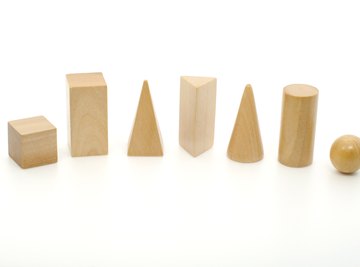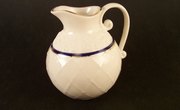
Geometric volume is the the amount of space inside a solid shape. To teach geometric volume, first give your students concrete experience with manipulatives so they can fully understand the concept of volume. Then, guide them so they will discover the relationship between surface area and volume so they can predict the formula for volume. Next, give them real-life problems to solve.
Discover Volume
Instruct your students to construct a rectangular prism with linking cubes. The length should be six cubes, the width four cubes and the height one cube. Guide them to use what they know about the formula for surface area to predict how many cubes they used, and then have them count the cubes to see if their prediction is correct. The answer should be 24 cubes.
Next, instruct them to keep the length and width the same, but construct a prism that has a height of two cubes. They should again predict how many cubes they have and count to see if they are correct. The answer should be 48 cubes.
Continue with three cubes for the height. Guide them in discovering the formula for volume of a prism, which is length x width x height or l x w x h. Give the students the dimensions of a few rectangular prisms to allow them to practice finding the volume.
Volume of a Cylinder
Show the students a cylinder and ask them how many cubes would fit it in. Guide them as they discover that it is difficult to measure the volume of a cylinder with cubes because the cubes don’t fit into a round space.
Remind them about the relationship of surface area of a cube to volume of a cube and see if they can predict a way to solve the problem. Show them that the volume of a cylinder is the surface area of a circle times the height. The surface area of a circle is pi times the radius squared. So to calculate the volume of a cylinder, you take the surface area of a circle times the height, which is pi times the radius squared times the height or pi x r^2 x h.
Give them a few examples that have the measurement of the radius, and guide them as they practice.
Volume of a Pyramid
Show the students a pyramid. Ask them what will be tricky about predicting the volume of a pyramid. Because the sides of a pyramid slant, you can’t simply multiply the surface area of the base by the height. The formula for the volume of a pyramid is one-third times the base times the height or 1/3 b x h. Show the students the difference between the height, the distance straight up from the base to the point, and the slant length.
Real-Life Application
Students will remember how to solve geometric volume much better if they can see its real-life applications. Bring a bag of potting soil that shows the volume in cubic feet and a cylindrical flower pot. Ask the students how they can figure out how many flower pots the bag of potting soil can fill.
First, have them make a plan using the knowledge they have about volume. Explain that estimating is okay if the flower pot slopes slightly. Provide the tools they need, such as measuring tape and calculators.
After they have made a plan, let them make measurements and discoveries on their own. The key here is the process, not getting the exact right answer. For an extension activity, provide them with measurements for a garden box and see how many bags of potting soil they need to fill the box.
References
About the Author
Tabitha Burgtorf began her career in the education field in 1999. Her experience includes elementary and middle school teaching, curriculum writing and writing education-related articles. Burgtorf holds a Bachelor of Science in elementary education from George Fox University and is certified to teach in Colorado.
Photo Credits
Hui Sieng Hii/iStock/Getty Images
